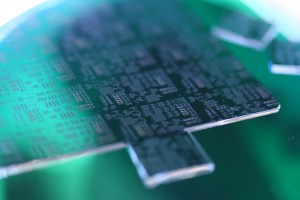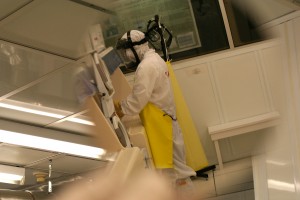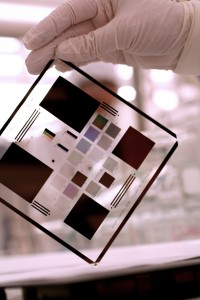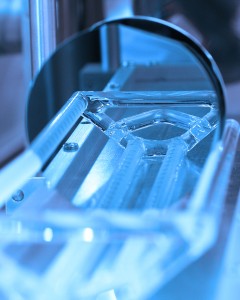
The nanoFAB will be hosting a free two-day workshop on fundamentals of vacuum systems and thin-film processing from May 14–15, 2019. Presented by J.R. Gaines from the Kurt J Lesker Company, this workshop is part of KJLC’s Lesker University course series, designed to provide attendees with a basic understanding of vacuum technology, proper vacuum practices, and effective thin-film deposition techniques. All nanoFAB users are invited to attend one or both days of the workshop, although registration is limited to 40 attendees per day. Lunch will be provided as part of the workshop.
Location: ETLC E2-100 Solarium East
Instructor: J.R. Gaines, Technical Director of Education, Kurt J. Lesker Company
Day 1: Vacuum technology
Date: Tuesday, May 14th, 2019
- 9:00 a.m. – 12:00 p.m. — Introduction to Vacuum Science and System Design
- 12:00 p.m. – 1:00 p.m. — Lunch
- 1:00 p.m. – 2:00 p.m. — Introduction to Vacuum Science and System Design (conclusion)
- 2:00 p.m. – 5:00 p.m. — Vacuum Pumps for High and Ultra High Vacuum Applications, Vacuum Gauging, Detection of Leaks in Vacuum Systems
Day 2: Thin-film processing
Date: Wednesday, May 15th, 2019
- 9:00 a.m. – 12:00 p.m. — Physical Vapour Deposition and Thin Film Growth Models
- 12:00 p.m. – 1:00 p.m. — Lunch
- 1:00 p.m. – 2:00 p.m. — Physical Vapour Deposition and Thin Film Growth Models (conclusion)
- 2:00 p.m. – 5:00 p.m. — Introduction to Atomic Layer Deposition
Please note that registration for this event is now CLOSED.
Workshop syllabus
Day 1: Vacuum technology
Introduction to Vacuum Science and System Design
This class is designed to introduce the student to basic concepts in vacuum technology. Subjects covered include molecular density in vacuum, the ideal gas law, molecular flow in various vacuum regimes, characteristics of gas composition at various molecular densities, general principles of gas-solid interactions, vacuum pump technology and the impact of fundamental design decisions and operating practices on vacuum system performance. It is intended for people who are new to vacuum or may not have any formal training. It also provides a general review for those who have had some formal training in vacuum technology. The student should achieve a general understanding of vacuum technology as a foundation for further training in vacuum system design and thin film deposition. This course also includes several short quizzes to better enable the learning process. Students who attend the class can receive a personalized certificate of attendance signed by the course instructor.
Specific topics include:
- Technical resources for vacuum technology
- Pressure and molecular density
- Adsorption, desorption, diffusion, and permeation
- Gas–solid interactions
- Flow regimes
- Conductance
- Vacuum pump technologies, pumping speed, and pump throughput
- Detecting leaks in vacuum systems
- Pressure measurement in vacuum
- Valves and Seals for high and ultra-high vacuum
- Gas load
- Effects of humidity on vacuum system performance
- Outgassing
- Surface finishes for vacuum applications
- Calculations of ultimate base pressure of a vacuum system
Vacuum Pumps for High and Ultra High Vacuum Applications
There is no one vacuum pump technology that will take a system from atmosphere down to high or ultra-high vacuum. Vast differences in molecular density from laminar flow to molecular flow require the utilization of two or more approaches. This course provides fundamental descriptions of the basic vacuum pumps and pumping mechanisms in current practice and provides insight into the various pros and cons for each approach in order to provide a basic understanding with which to guide pump selection for vacuum technologists. Students who attend the class can receive a personalized certificate of attendance signed by the course instructor.
Specific topics include:
- Technical references for vacuum pumps
- Pressure regimes
- Types of vacuum pumps and pumping technologies
- Wet vs. dry pumps
- Pumping speed
- Pump throughput
- Rotary vane pumps
- Dry scroll pumps
- Diaphragm pumps
- Cryo pumps
- Turbomolecular pumps and hybrids
- Diffusion pumps
- Ion pumps
- Titanium sublimation pumps
- Non-evaporable getter (NEG) pumps
Vacuum Gauging
Like vacuum pump technology, the vast differences in molecular density at atmosphere and high or ultra-high vacuum require a multitude of pressure measurement techniques. This course describes a wide range of pressure measurement approaches as well as the pros and cons of each device. Certain process-specific characteristics are identified that might guide the user on the selection of the suite of instruments required to cover large pressure ranges. We encourage coupling this course with our Introduction to Vacuum Technology. Students who attend the class can receive a personalized certificate of attendance signed by the course instructor.
Specific topics include:
- Gas pressure
- What makes vacuum pressure difficult to measure?
- The Ideal Gas Law and gas law variables
- Gas-dependent vs. gas-independent gauges
- Examples of gauging systems
Detection of Leaks in Vacuum Systems
The identification of gas sources that prevent to achievement of high or ultra-high vacuum is critical to the performance of any vacuum system. This course provides an overview of potential gas sources, such as leaks, permeation, outgassing and poor vacuum cleanliness. The definition and detection of leaks is discussed in detail and various approaches, specific to leak size and system pressure are described. We encourage coupling this course with our Introduction to Vacuum Technology. Students who attend the class can receive a personalized certificate of attendance signed by the course instructor.
Specific topics include:
- Technical references for helium leak detection
- Types of leaks
- Detection methods
- Basics of helium leak detectors
- Practical guidelines
Day 2: Thin-film processing
Physical Vapour Deposition and Thin Film Growth Models
This class is designed to introduce the student to fundamental concepts and operating principles for the deposition of thin films by thermal and e-beam evaporation as well as sputtering by DC and RF techniques. It includes a recap of basic vacuum technology, followed by fundamental design and operational aspects of each thin film deposition technique as it impacts thin film properties. Issues such as deposition rate, film uniformity, morphology and density are discussed. Several growth models are presented with reference to how specific materials properties and deposition conditions may affect thin film morphology. The student should achieve a general understanding of thin film deposition by physical vapour techniques and be familiarized with available resources for further training. This course also includes several short quizzes to better enable the learning process. Students who attend the class can receive a personalized certificate of attendance signed by the course instructor.
Specific topics include:
- Introduction
- References on thin film deposition technologies
- Introduction to basic vacuum
- Depositing thin films by:
- Thermal evaporation
- E-beam evaporation
- Sputtering by direct current (DC) magnetron
- Sputtering by radio frequency (RF) magnetron
- Sputtering using pulsed processes – i.e. HiPIMs
- Cathodic arc deposition (if there is interest)
- Thin film growth models
- Layer growth
- Island growth
- Combined layer and island growth
- The Structure Zone Model(s)
- Effects of deposition conditions on film characteristics, including:
- Stress in thin films
- Thickness effects
- Effect of chamber pressure on film properties
- Deposition rate and film characteristics
- Enhanced deposition techniques
- Combinatorial magnetron sputtering
- Glancing angle deposition
- Atomic layer deposition
Introduction to Atomic Layer Deposition
This class is designed to introduce the student to fundamental concepts and operating principles for the deposition of thin films by atomic layer deposition (ALD). It includes a discussion of the motivation behind ALD and some insights into the operational aspects of this thin film deposition technique as they impact thin film properties. Issues such as gas flows, chemical reactions, deposition rate, thermal window and the impact of enhanced plasma processing are discussed. The student should achieve a general understanding of thin film deposition by ALD and be familiarized with available resources for further training. This course also includes several short quizzes to better enable the learning process. Students who attend the class can receive a personalized certificate of attendance signed by the course instructor.
Specific topics include:
- Motivation for Atomic Layer Deposition (ALD)
- The ALD process in ideal conditions
- Review of basic vacuum and flow regimes critical to ALD
- Laminar flow
- Viscous or turbulent flow
- Evolution of ALD reactor designs
- ALD in non-ideal conditions
- The impact of chaos
- Thin film growth models
- Recent advances in process design
- Addition of plasmas
- Enhanced reactivity of precursors and carrier gases
- Alternative pulse regimes
- Impact of the ALD process on balance-of-plant (i.e., pumping systems)
- Recent examples of device solutions achieved using ALD





